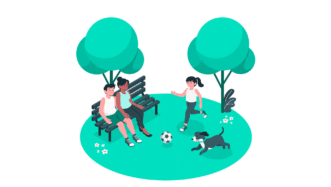LESSON OVERVIEW
The main objectives of this lesson are to:
- talk about students’ schedules using time expressions;
- watch and discuss videos on peoples’ bedtimes;
- learn about and practise Present Simple questions.
With this lesson, students talk about their habits and schedules! They learn how to correctly talk about time, explore time expressions, and practise Present Simple questions. They share the times they do things and learn about their partner’s habits. Students practise listening skills by watching videos of people talking about their bedtimes. Alos, they do tasks to understand how to form Present Simple questions and put it into practice by asking each other questions.
WARM-UP AND VIDEO
This lesson starts with a warm-up in which students look at photos. They answer questions about them, using ideas provided in brackets. Next, they match statements about common habits with their typical times (e.g. lunchtime, bedtime). Afterwards, they do tasks to practise writing and understanding times using numbers (e.g. 11.30, 12.15). Following that, students say what time they do common things (e.g. have a shower). Their partner listens and writes down their answer. Then, students switch roles. You can also encourage students to share what they’ve learned about their partner’s day! Next, students prepare to practise Present Simple questions by watching part of a video in which people reveal their bedtime what time, ticking the times they hear. Following that, they watch part of a similar video, but this time, they choose the words or phrases they hear from the options provided. Then, they discuss some questions.
GRAMMAR AND MORE PRACTICE
Students begin to practise Present Simple questions by matching questions with answers. They learn about the grammar through various tasks. Firstly, they look at the questions in the previous exercise and complete a table with words from the questions. They do an exercise in which they provide the negative (‘opposite’) answer to the question ‘Do you like apples?’ (i.e. No, I don’t). They complete more short answers in affirmative and negative forms. Next, students look at a list of questions and complete the gaps with one word in each question. They choose a question and ask their partner. Students take turns and continue with the other questions. Students then look at the boxes with words and create seven more questions. They start each question using a different word or phrase from the first box (e.g. what, how often…?). They ask their partner the question they created and answer theirs.
HOMEWORK/REVISION
This lesson plan also includes an additional task that you can use as homework or revision. In the task, students put words into the correct order to create questions, and then answer the questions. The task is available in the teacher’s version of the worksheet. You can print it and hand it out to your students. It’s also included in the e-lesson plan.
WORKSHEETS
Subscribe to unlock these and many other Standalone lesson lesson plans with the Unlimited plan
Subscribe











I’m really happy to see that A1 lessons have been added to the site. I’m not very keen on having beginner groups, but I’ve just been assigned one, and it’s great to have online materials available. Thank you!
I was a bit hasty with my comment earlier. Now that I’m going through the lesson more thoroughly, I see things differently. I know the slides are freely editable and can be arranged in any order, but an A1 student won’t immediately grasp the concept of auxiliary verbs, let alone that they change with pronouns. Plus, the first slide introduces pictures that relate more to the present continuous tense. At the A1 level, it might be better to start with statements and word order. Based on its structure, I would categorize this lesson as more suitable for the A2 level. Starting with the present continuous isn’t a bad idea, since it’s used more frequently than the simple present, but in that case, the lesson should continue with that focus.
I want to echo both of your comments. I’m happy to see this platform creating A1 lessons. Clearly there is a lot of demand from us teachers for A1 lessons for adults…why? Because it’s really hard to create engaging lesson plans for A1 adults. I hope ESL Brains continues to hone this effort, we need it!
Hi! Thanks for your comments. We recommend that you do the lesson as part of the Present Simple set. This is the fourth and the last lesson in the set. Students learn auxialiary verbs in lesson 3 of the set. And ex. 1 is just a warm-up whose purpose is to get students talking a bit.
Hi, thanks Ewa. I found the set. I still need to get used to the fact that the lessons are organized into sets 🙂
Hello,
“How often do you usually go to bed at midnight?” – maybe without “usually”, right?
You’re absolutely right, thanks! It’s fixed now.
I cannot find “Wh questions” lesson
Hi! There is no lesson on just ‘Wh’ questions. Students are first exposed to some ‘Wh’ questions here. And in this lesson (‘What time do you…?’), they work out the meaning of different ‘Wh’ question words in ex. 8 and then practise them in ex. 10 and 12.
High! I’ve noticed this: slide 39, question D, the question mark is missing. Other than that, I love these presentations. Peace!
Hi! It’s now added! We’re happy you find them useful 🙂